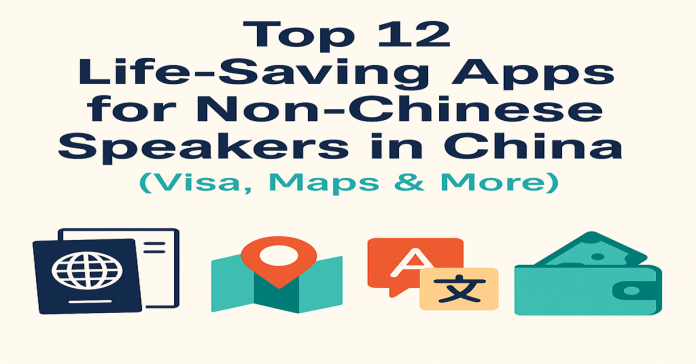Traveling to China is exciting—but for many foreigners, the language barrier makes it stressful. That’s why the smartest move is to prepare with the best apps for non-Chinese speakers in China. Whether you need to check visa requirements, translate menus, find local gems, book a ride, or pay without cash, these tools make your trip smooth and stress-free.
In this guide, we’ll cover the top travel apps for tourists in China—starting with visa checkers, then moving on to translations, social media, maps, payments, transport, and more.
Apps at a Glance
| App / Tool | Use Case | Why It’s Useful for Non-Chinese Speakers |
|---|---|---|
| iVisa / CVASC | Visa requirement checks | Quick updates on whether you need a visa |
| Pleco / Youdao | Translation & dictionary | Offline camera/text translation, accurate for Chinese |
| Xiaohongshu (RED) | Social media & reviews | Real local tips, hidden gems, restaurant finds |
| Baidu Maps / Amap | Navigation & maps | More accurate than Google Maps in China |
| Messaging, payments, bookings | China’s all-in-one “super app” | |
| Alipay | Mobile payments | Easy to link international cards for cashless travel |
| DiDi | Taxi & ride-hailing | Uber alternative with English support |
| Trip.com | Flights, hotels, train tickets | Foreigner-friendly booking platform |
| ExpressVPN / NordVPN | Internet access | Bypass Great Firewall to use Google, WhatsApp, Gmail |
| Dianping | Food & restaurant reviews | China’s Yelp for authentic dining spots |
| AirVisual / China AQI | Air quality & weather | Real-time updates to plan safe outings |
| XE / OANDA | Currency converter | Prevents overpaying and confusion with RMB |
1. Visa Checker Tools
Before you even pack your bags, you’ll need to know if you require a visa. Websites like iVisa or the official China Visa Application Service Center (CVASC) let you check requirements instantly. Some China travel apps for foreigners even send updates if rules change. Having a visa checker avoids last-minute surprises and ensures your trip gets off to the right start.
2. Pleco & Youdao Translate
Instead of Google Translate, which is often unreliable in China, download Pleco—a powerful offline dictionary designed for foreigners. It shows pronunciation, stroke order, and even example sentences. Another option is Youdao Translate, widely used by locals and more accurate for Chinese text. Both are essential apps for non-Chinese speakers in China who need to read menus, signs, and tickets on the go.
3. Xiaohongshu (Little Red Book)
Think of Xiaohongshu (RED app) as Instagram, Pinterest, and TripAdvisor combined. Locals share authentic reviews of restaurants, attractions, and shopping spots—with real photos. Even if you don’t speak Chinese, using it with Pleco or Youdao makes it easy to find hidden gems. For many foreigners, Xiaohongshu is the secret weapon for exploring beyond the usual tourist guides.
4. Maps: Baidu Maps & Amap
Google Maps has limited accuracy in China. Instead, locals rely on Baidu Maps or Amap (Gaode Maps) for reliable navigation. Both apps are in Chinese, but when combined with Pleco or Youdao, they’re far more accurate than Google. For non-Chinese speakers traveling in China, having one of these map apps means you won’t get stuck or misdirected.
5. WeChat
WeChat is not just a messaging app—it’s China’s “super app.” You’ll use it for chatting with locals, booking tickets, paying bills, scanning QR codes, and even checking into attractions. It also has built-in translation for messages, making it one of the most powerful apps for foreigners in China who want to stay connected and navigate daily life.
6. Alipay
Cash is almost extinct in China, and foreigners often struggle without mobile payment. Alipay recently made it easier for tourists by allowing international credit card linking. From luxury malls to small street vendors, everyone accepts Alipay. It’s one of the most essential apps for non-Chinese speakers in China—without it, you’ll constantly worry about how to pay.
7. DiDi (China’s Uber)
Taxi drivers in China may not speak English, and negotiating fares can be stressful. DiDi is the easiest solution—it works just like Uber, with English support and card payments. This makes it one of the best apps for tourists in China who want reliable, hassle-free transportation.
8. Trip.com
For trains, flights, and hotels, Trip.com is the top choice. Unlike China’s official railway app (12306), Trip.com is in English and easy for foreigners. Many non-Chinese speakers in China rely on it to book travel without confusion or complicated steps.
9. VPN Apps (ExpressVPN / NordVPN)
China’s internet is heavily restricted by the Great Firewall. Without a VPN, you can’t access Gmail, WhatsApp, Instagram, or even many news sites. ExpressVPN and NordVPN are reliable for bypassing restrictions. For many foreigners in China, a VPN is just as essential as a payment or translation app.
10. Dianping (China’s Yelp)
Wondering what to eat? Dianping is China’s version of Yelp, packed with reviews, ratings, and food photos. While it’s mainly in Chinese, pairing it with Pleco makes it one of the most powerful apps for non-Chinese speakers in China who want to eat like locals instead of relying only on tourist restaurants.
11. Air Quality & Weather Apps
Air quality in China can vary from city to city. Apps like AirVisual or China AQI give real-time updates, which are especially important for families or anyone with health concerns. Pairing this with a weather app helps you plan your days more safely.
12. Currency Converter Apps
Finally, avoid confusion with RMB pricing by using XE or OANDA. With real-time exchange rates, you can make sure you’re paying fair prices when shopping or bargaining. It’s one of the small but essential China travel apps for non-Chinese speakers.
Final Tips for Non-Chinese Speakers Traveling in China
The best way to survive and thrive in China as a foreigner is to load up your phone with the right tools. The top apps for non-Chinese speakers in China cover every stage of the journey—from visa and translations to maps, payments, transport, and food.
👉 Pro tip: Download and set up these apps before you arrive in China, since some require registration outside the country. Also, check key Chinese holiday dates like Golden Week (early October) and Chinese New Year (January–February), when crowds are at their peak. With these essential China travel apps—and a smart plan—you’ll avoid stress, travel like a local, and enjoy a smoother, more confident trip.




